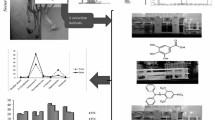The fatty acid compositions of the leaves and fruit of Solanum dulcamara were determined by gas chromatography. The leaf oil of S. dulcamara is remarkably rich in linolenic acid. Among the S. dulcamara extracts, according to the 2,2-diphenyl-2-picrylhydrazyl method, hexane and methanol show the highest activity levels in fruit and leaves, respectively. According to the β-carotene-linoleic acid method, dichloromethane has the highest activity level in both fruit and leaf. However, according to the modified cupric-reducing antioxidant capacity method, ethyl acetate and dichloromethane have the highest activity levels in fruit and leaves, respectively. The antioxidant activity levels and fatty acid contents of S. dulcamara are presented for the first time in this study.


Similar content being viewed by others
References
D. Bown, Encyclopedia of Herbs and Their Uses, Dorling Kindersley Press, London, 1995.
W. C. Evans, Trease and Evan’s Pharmacognosy, 14th ed., W. B. Saunders Company Press, Edinburgh, 1996, 638 pp.
T. Baytop, Turkiye’de Bitkilerle Tedavi, Nobel Tip Kitabevi, Istanbul, Turkey, 1999, 243 pp.
N. Tanker, M. Koyuncu, and M. Coskun, Farmasotik Botanik, Ankara Univ. Press, Ankara, Turkey, 1998.
M. Grieve, A Modern Herbal, Vol. II, Dover Publications Inc., New York, 1982, 589 pp.
A. Chevallier, The Encyclopedia of Medicinal Plants, Darling Kindersley Limited, London, 1996, 268 pp.
K. O. Chatigre and N. G. Agbo, in: Proceedings of the Second International Workshop on African Pear Improvement and Other new Sources of Vegetable Oils, Cameron, 1998, 209 pp.
E. I. Lucini, N. R. Grosso, and A. L. Lamarque, J. Agric. Food Chem., 42, 2743 (1994).
J. R. Dhellot, E. Matouba, and M. G. Maloumbi, Afr. J. Biotech., 5, 987 (2006).
C. O. Eromosele and I. C. Eromosele, Biores. Technol., 82, 303 (2002).
C. Paquot and A. Hautfenne, International Union of Pure and Applied Chemistry (IUPAC), in: Standard Method for the Analysis of Oils, Fats and Derivatives, 7th ed., Blackwell Scientific Publications, London, 1987.
M. S. Blois, Nature, 181, 1198 (1958).
C. Sanchez-Moreno, J. A. Larrauri, and F. Saura-Calixto, J. Sci. Food Agric., 76, 270 (1998).
I. Amin and S. H. Tan, Malaysian J. Nutr., 8, 167 (2002).
R. Apak, K. Guclu, M. Ozyurek, and S. E. Karademir, J. Agric. Food Chem., 52, 7970 (2004).
I. Gulcin, J. Enzyme Inhib. Med. Chem., 23, 871 (2008).
Acknowledgment
We thank Namik Kemal University for financial support (NKU-BAP.00.10.AR.12.13).
Author information
Authors and Affiliations
Corresponding author
Additional information
Published in Khimiya Prirodnykh Soedinenii, No. 1, January–February, 2017, pp. 14–16.
Rights and permissions
About this article
Cite this article
Makasci Afacan, A., Sabudak, T., Ortakoy, T. et al. Investigation of Antioxidant Activity and Fatty Acid Contents of Solanum dulcamara . Chem Nat Compd 53, 12–15 (2017). https://doi.org/10.1007/s10600-017-1899-1
Received:
Published:
Issue Date:
DOI: https://doi.org/10.1007/s10600-017-1899-1



